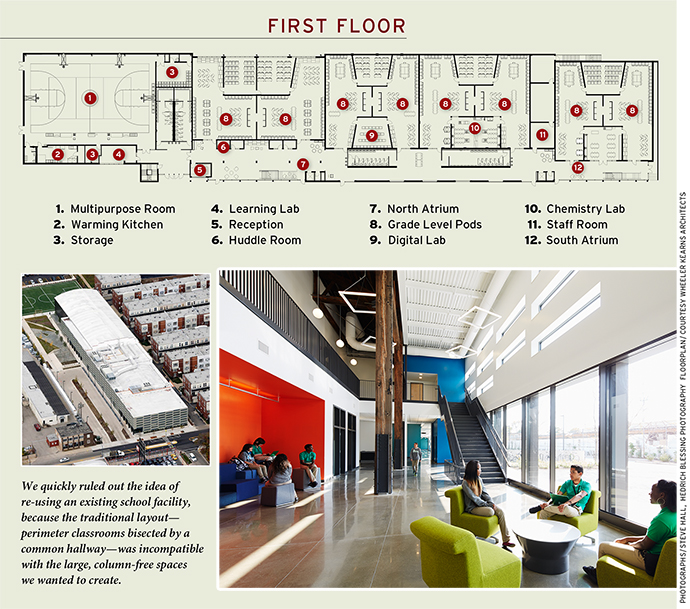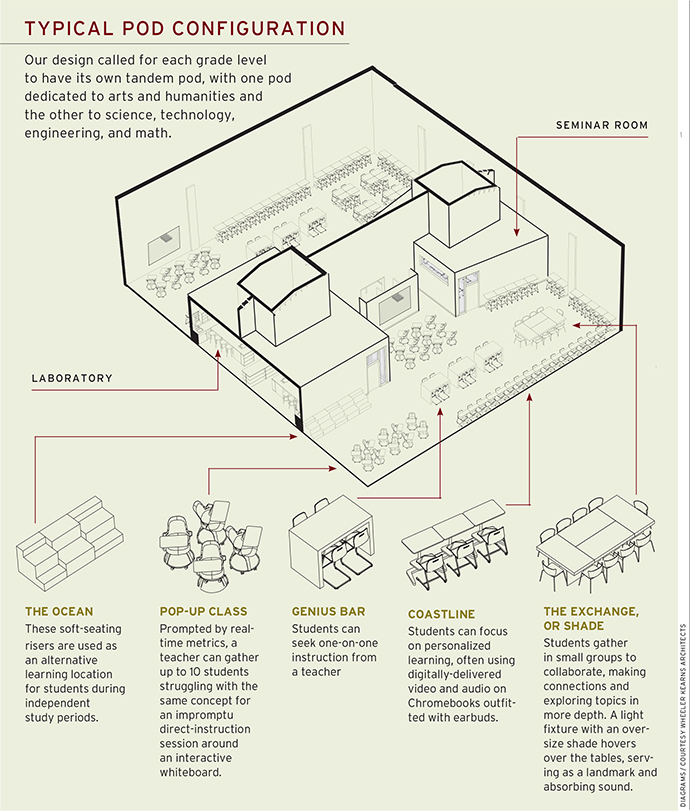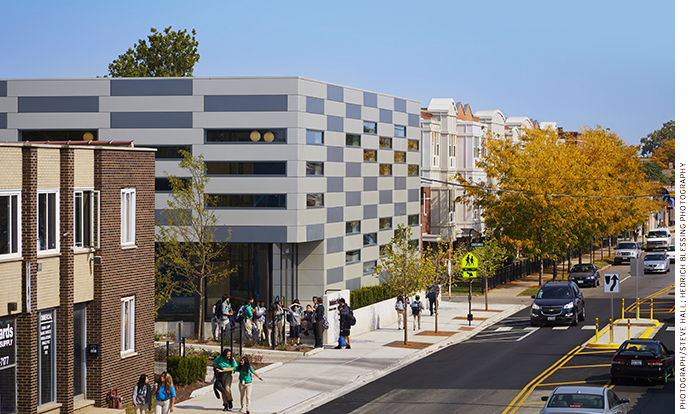
Blended Learning uses school time in a unique way, combining online instruction with traditional methods and giving students more agency over how, when, and where they learn. That third variable, the “where,” calls for some serious rethinking of how school space is organized and deployed. In our architectural practice, we have found that design either supports or frustrates a school’s mission—it is never an “innocent bystander.”
This is particularly true for blended environments, where multiple activities happen at once: a small group of students might be listening to the teacher review a math concept, for instance, while others work nearby on a team science project, and still others work individually on wireless laptops. In a traditional classroom, this welter of activity would be impossible. Blended schools need a different blueprint.
At Wheeler Kearns Architects, an 18-person practice in Chicago, we recently had the opportunity to design, from scratch, new facilities for two charter schools, each one using a distinct blended-learning model. At both schools—one in our city and one in Los Angeles—educators saw blended learning as a way to custom-tailor the school experience for urban students whose backgrounds and learning needs varied widely. They hoped to personalize the education of each student and avoid the limitations of “teaching to the middle.”
Blended learning—sometimes called hybrid learning—has been gaining ground in this country since the 1990s, as computer devices have become more personal, portable, and affordable. Hard data on its prevalence are hard to find, but a large majority of school districts have adopted blended learning at least to some degree, and many charter schools are using it “to rethink the entire school experience,” according to Michael B. Horn of the Christensen Institute.

Intrinsic Schools
Melissa Zaikos began experimenting with online learning in the Chicago Public Schools, where she spent nine years as a Broad Fellow, most notably, running a group of high-performing schools on the southwest side of the city. After seeing promising results there, Zaikos left CPS to found Intrinsic Schools. With her first charter in hand, she started looking for a space to house a 900-student school and scale up her work with blended learning.
“When we created Intrinsic, we had two goals,” Zaikos said. “First, we wanted to create life-changing opportunities and foster postsecondary success for our students. Second, we wanted to create a road map for other educators on how to do this in a sustainable and replicable way. The design of our school was critical to achieving both goals.”
In 2012, Zaikos commissioned our firm to design the school, which would be Chicago’s first high school built specifically for blended learning. She chose to use a rotational model of blended learning, one of several variations on the approach. Under this model, students rotate among learning methods throughout the day, including online learning. Typically, the school day might also include teacher instruction to small groups or one-on-one, plus collaborative projects and individual paper-and-pencil work. Our challenge was to create a variety of dedicated spaces where students could work relatively distraction-free yet teachers could still see and supervise the whole class.
A team of Intrinsic educators visited successful blended schools throughout the country while our firm started working on drawings and models for possible layouts. We followed a “design thinking” process, first empathizing as best we could with students and instructors to help us understand their daily challenges, then prototyping and testing our ideas. For the prototype phase, Intrinsic staged two pilots during school holidays, borrowing the multipurpose areas of neighborhood schools, where teachers could interact with students who volunteered to participate. These pilot sites, which we outfitted with trial furniture that supported specific activities, allowed the educators to test layouts, scheduling, student engagement, and learning. After each pilot, we responded to the gathered feedback with new iterations of the design.
In parallel, the team was searching for a building site large enough to accommodate 900 students in one of Chicago’s high-need areas. We wanted to create large, column-free spaces, and the ubiquitous layout of traditional schools—perimeter classrooms bisected by a common hallway—made that goal expensive or impossible. So we quickly ruled out using an existing school facility and focused our search on former industrial sites, most of which were located adjacent to highly populated neighborhoods. Ultimately, we chose the site of a shuttered lumberyard on W. Belmont Avenue. The buildings on the site had large, open floors and tall ceilings that could accommodate the open studios we wanted to create within “pods” for each grade, from 7th through 12th.
Unexpected delays in the purchase of the site serendipitously compelled the school to incubate its first class in a rented space downtown, formerly used by a college. This setback turned out to be a hidden blessing, because it allowed us to further test our designs before making them final. Feedback from these early experiences dramatically altered our design. For instance, we set up open studios in the rented building and outfitted them with mobile, flexible-use furniture. While this concept made perfect sense on paper, the studios soon began to look like bumper-car sheds. The chaos became stressful to navigate, since the furniture gave no physical clues as to where certain types of learning were meant to take place. We realized we would have to find ways to visually differentiate the learning environments from one another.
Form Follows Function
Construction on the first Intrinsic School began during Chicago’s famed “polar vortex” winter of 2013. We retained three buildings on the site that were constructed between 1911 and 1955. Two of them featured historic arcing wood-truss roofs that free-spanned from one exterior brick wall to the other. Supplemented by additions that expanded the footprint by 25 percent, the historic structures were preserved and restored—with beams, trusses, and brick walls intentionally left exposed to the 21st-century learning environment. Underneath the 40-foot-high roof of an open shed built in 1955, a new two-story steel-frame building was built like a ship in a bottle.
Our design called for each grade level to have its own tandem pod, with one pod dedicated to arts and humanities and the other to science, technology, engineering, and math (STEM). As a nod to the architecture of the human brain, we located the humanities on the right and STEM on the left when viewed from the corridor. Students move back and forth between the two sides of the pod throughout the day.
Instead of bisecting the building, the corridor runs lengthwise along the outside, flooded with light from oversize windows. This corridor, which culminates in an atrium near the entry, is often the first nontraditional feature that new visitors notice. There are no central, locker-lined corridors to be found.
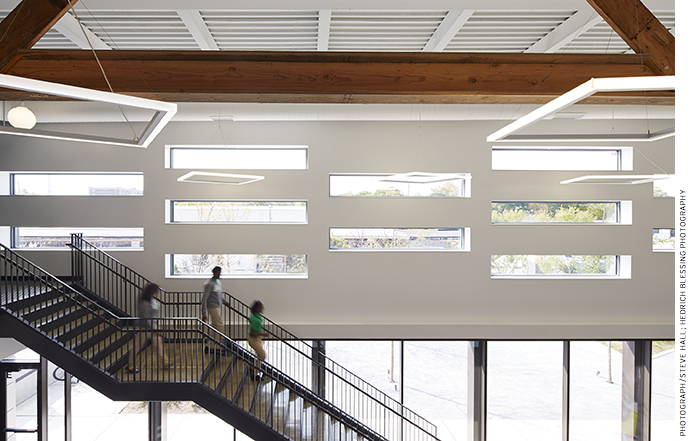
Each tandem pod can accommodate 180 students and eight instructors in a given grade, who navigate 10 distinct learning environments within a total of 5,500 square feet. An open studio occupies the main space of each subject-area pod, holding 60 students, three teachers, and four learning environments. Designing these studios proved complicated: we quickly realized that simply scaling up a rectangular classroom would not work for independent-learning environments that needed to overlap, as in a Venn diagram. We had to provide some autonomy for each activity without sacrificing visual connection and the ability of teachers to supervise. This is the double-edged sword of modern open learning spaces. Although they liberate people from the isolation of repetitive cellular rooms, they set up conditions where distractions are likely.
In the end, we decided on two irregular footprints for the open studios—a T-shape and an L-shape—to foster a balance between autonomy and openness. These shapes could be interlocked with two enclosed, soundproof rooms—a seminar room for humanities and a lab for STEM—to form an overall rectangular shape for the tandem pod. These additional spaces allow for teachers to hold Socratic seminars without disturbances and for students to conduct lab exercises in a contained space where safety measures can be observed.
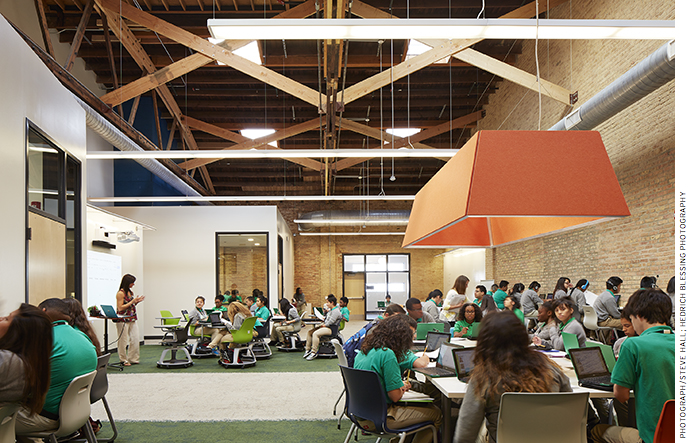
Different shades of carpeting on the floor subtly delineate the open studio’s separate learning environments, each tailored to a specific use. Below an oversize, sound-absorbing light shade, which serves as a landmark, a large table facilitates group projects and peer-to-peer learning. Small-group, teacher-led instruction takes place in two “pop-up” learning areas with mobile chairs and ultra-short-throw projectors mounted above walls painted as whiteboards.
Originally, we had planned for students to do their individual work at traditional long tables, sitting across from one another. This idea didn’t work: teachers found the tables difficult to supervise, and students distracted one another. So we installed counter-style desks of varying heights around the perimeter of the open studio, creating a “coastline” where students could concentrate on individual tasks, including personalized online learning.
In our planning interviews with teachers, they expressed no interest in having traditional desks of their own. Within weeks of the school’s incubation opening, though, many teachers had appropriated a student desk for themselves, setting it up near the middle of the room. At the permanent campus, we formalized their organic solution by creating a central “genius bar” in each open studio, where students could seek one-on-one instruction from a teacher.
As a “1:1” campus, Intrinsic assigns each student his or her own Chromebook computer, enabling students to move about while the teacher can monitor their progress in real time via the school’s robust wireless network. Ultimately, Intrinsic hopes to tailor instruction to small groups that form dynamically in response to just-completed student work. Teachers will know immediately which students are at similar points in their learning and will be able to efficiently help them progress.
Effective blended-learning spaces not only foster smooth and seamless activities within the class, they also nurture communication, both verbal and nonverbal, between instructors working as a team. Traditional classrooms isolate teachers from one another much of the time, while blended spaces support collaboration between master instructors, new teachers, and special educators. In fact, this ease of communication was one of the benefits most cited by Intrinsic’s founding teachers.
Maggie Culhane, a 10th-grade English instructor, said, “Brainstorming with two other people who are as invested as you are in your classroom—because it is their classroom, too—transforms teaching. The pod space allows me to innovate; my pod-mates compel me to.”
Although Intrinsic’s main learning spaces use an open plan, they differ from the “open classrooms” of the 1960s and 1970s in important ways. Most obviously, a blended classroom is powered by digital technology, which allows learners to access rich textual, graphic, interactive, video, and audio content unknown to the students of the past. Second, the open-classroom movement revered the notion of “universal space” that could be sliced and rearranged at will and for any purpose. Most any activity could happen anywhere, without regard for adjacent activities. In contrast, today’s open-learning environments are not interchangeable but are designed for a dedicated purpose. They interlock with one another to minimize disturbances and foster positive interactions. In the case of Intrinsic Schools, a few of the most effective couplings were unexpected. For example, wrapping a “coastline” of individuals, often listening to personalized content through earbuds, around the spirited conversations of a peer-to-peer learning table, works quite well.
While searching for precedents for Intrinsic, we encountered several schools that had merely knocked down walls between traditional classrooms to create larger spaces. We noted that the resulting rooms lacked intuitive landmarks and visual cues, making it difficult to quickly “read” what should happen where. Supersizing a traditional classroom without adapting it to blended learning can create a stressful and ineffective environment.
Ednovate
Our second client was Oliver Sicat, whom we had known as a founding principal of a charter network in Chicago. Sicat now leads the University of Southern California’s charter network, Ednovate, which focuses on high schools in high-need areas in and around Los Angeles. He came back to Chicago to tour Intrinsic’s campus, and in 2016 commissioned us to design a new Ednovate high school in the Exposition Park neighborhood of Los Angeles. USC Hybrid High, which currently occupies a facility downtown, plans to relocate to the new building in fall 2017.
Ednovate high schools, all college prep, seek not only to prepare students for postsecondary success but to equip them to use their college degrees and subsequent careers to effect multi-generational change in their communities. Just as first-generation college graduates provide role models for younger people and establish new expectations for their own children, the older students at Ednovate model successful behaviors for the underclass students. As students progress through their four years, they are given increased agency over their own learning. Seniors complete their experience with a yearlong capstone project that attempts to solve a social problem or otherwise improve the community. Sicat wanted to make the seniors’ work visible to their younger peers, a goal that traditional isolated classrooms would not support. He envisioned a more open environment and opted for the flex model of blended learning.
Under the flex model, students can adjust the time spent on different modes of learning to improve their outcomes. Throughout the day, they can choose to participate in online and offline activities, with teachers providing support through small-group or individualized instruction and guidance on projects. Sicat sees the flex model as a good fit for project-based learning.
In cooperation with its partner, Pacific Charter School Development (PCSD), Ednovate located four lots along South Vermont Avenue facing the Los Angeles Memorial Coliseum. The four unrelated buildings on the site did not suit Ednovate’s purpose, so the project required ground-up new construction. In cooperation with PCSD’s architect, NAC Architecture, we were commissioned to design a 460-student high school that not only supported Ednovate’s blended-learning model but also put the seniors on display as they worked on their capstone projects. And, though Ednovate’s budget precluded a formal auditorium, the school wanted a prominent stage where the seniors could present their completed work.
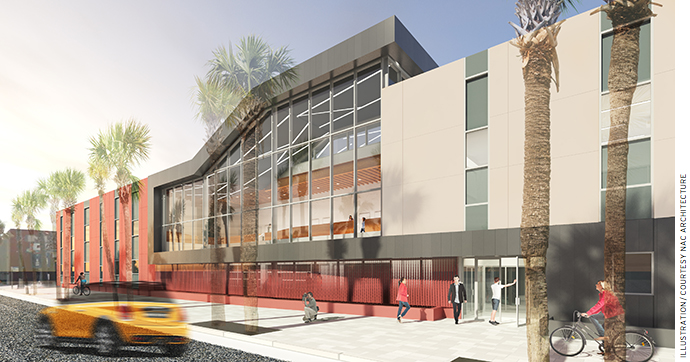
With students deciding what they need to learn and how to learn it, the hope is that such autonomy will promote student engagement and breed the independence that fosters success in college. In theory, a flex environment must be able to accommodate all students choosing to engage in the same mode of learning at the same time. But with a limited capital budget, dedicating space for “peak occupancy” for every learning mode would be impractical. Instead, the environment must be flexible, as the model’s moniker implies.
Our solution was to design a “quad-pod” for each grade level. In Ednovate’s case, a pod is a classroom-like space, acoustically but not visually isolated from adjacent spaces, that serves as the home base for a single grade-level teacher. Four pods arranged around a central open studio host each grade, with each pod accommodating up to 32 students. In Ednovate’s parlance, the open studio is a space that can be recruited on the fly by students working independently or in small groups. It will also serve as a daily meeting space for one of five student advisory groups at each grade level. In its most communal form, the studio can combine with one of the pods to create an oversize pod that can accommodate a standup meeting for a whole grade.
The central feature of Ednovate’s two-story campus fulfills two critical requirements. In the heart of the school along Vermont Avenue’s sidewalk, a double-height space will serve as the seniors’ open studio and an amphitheater for their capstone project presentations. Flanked by the quad-pods of the underclass students, the space exposes the work routines of seniors to their younger counterparts. Instead of surrounding the open studio, the four pods of the senior teachers border one side, where the instructors can supervise activities through clear glass walls.
At the upper level of the central space, two continuous rows of built-in seats encircle the seniors’ open studio, with a view of an area on the ground floor, where a stage can be erected as needed for formal presentations. On a daily basis, seniors and teachers can work at the built-in seats, facing a view of the city they are striving to improve.
This feature is but one illustration of how the design process centered on Sicat’s vision of learning, which fosters “positive multi-generational change,” he said. “From younger students observing older ones to our whole school community looking out to both south central Los Angeles and the University of Southern California, our school is a canvas for students to explore their passions and purpose.”
All or Nothing?
Our work for Intrinsic and Ednovate drew the interest of several public-school districts that wanted to learn more about the unique facility demands of blended learning. Often, these educators were seeking to “hedge their bets” on blended learning, hoping for reversible spaces that could be reconverted to traditional cellular classrooms if need be. To date, such a design has eluded us, because the ideal environments for the two learning approaches are so different. Just as the traditional school layout does not lend itself to repurposing for blended models, the inverse seems to be true as well.
The distinct nature of blended-learning spaces was illustrated during a workshop we conducted with Michael Horn at the SXSWedu education conference in early 2016. We asked groups of participating educators to develop hypothetical designs for open-studio spaces that integrated multiple modes of learning and distinct environments. Notably, the vast majority of the groups chose L- or T-shaped footprints, as we had for Intrinsic. Like us, they reasoned that blended-learning activities needed both independence and overlap in order to optimize autonomy, communication, and supervision.
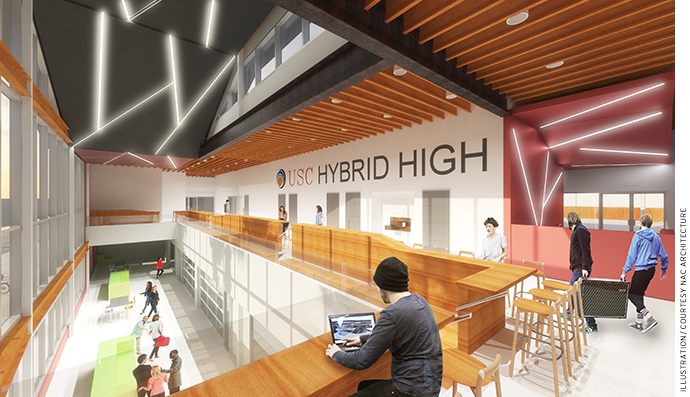
Cost and Efficiency
The public school districts that have contacted us have been particularly interested in the cost implications of blended-learning spaces, since our analysis suggests that blended environments are more efficient and less expensive to build.
Intrinsic’s and Ednovate’s facilities measure 59,000 and 30,000 square feet, respectively, yielding 62 to 65 square feet of gross area per student, just a little over one-third of what district schools generally provide in Greater Chicago. Still, in the two blended schools, the area dedicated to core learning spaces is 55 percent and 62 percent, respectively, of the total floor area. In contrast, newer traditional district schools dedicate between 20 percent and 30 percent of their footprint to core learning spaces. Most of that difference derives from the fact that the two blended schools, like many charter schools, did not include facilities such as cafeterias and traditional libraries. But space savings also accrued from the more compact pedestrian circulation in the two schools. Areas dedicated to circulation constitute 16 percent of total space at Intrinsic and 17 percent at Ednovate, compared with an average of 25 percent in larger traditional schools.
The relative construction cost of blended facilities also tends to be lower. First, the smaller number of rooms saves money, since every separate room requires its own walls, door, light switches, alarm strobes, and climate control. Such interior-and-systems costs typically represent about 60 percent of total construction costs. We estimate that blended-learning facilities save about 10 percent of costs in this category, or a 6 percent overall savings.
In our analyses, the cost savings of blended schools outstrip their differences in physical size, and these savings are not canceled out by the economies of scale that larger projects provide. If blended learning proves to be a more effective way to educate students, administrators concerned about construction cost should be pleased.
The Future
Some critics of blended learning question its reliance on digital technology, decrying the amount of time students spend in front of computer screens. Advocates, however, point out that that the real gold mined in the digital era is the more-effective use of a teacher’s time. In blended classrooms, teachers are as important as ever; in fact, their role is elevated.
The digital technology that powers blended learning will of course continue to evolve, creating new opportunities and making some more accessible. For instance, 3-D printers and laser cutters were virtually unknown in the consumer sphere just a few years ago. Today, schools typically consign such tools, if they have them, to specialized rooms like makerspaces. These and other technologies will likely follow the path of personal computers to become more affordable and ubiquitous.
We foresee other probable trends that could affect the future of blended learning. As schools stretch personalized learning, they will likely cooperate to support different types of learners more effectively. (For instance, we have seen blended-learning spaces starting to resemble those designed for students with learning differences.) Rather than being located predominantly in residential neighborhoods, many schools will migrate to commercial streets, where they can capitalize on transportation networks. Instead of being located in monumental standalone buildings, schools will often inhabit multiuse buildings that foster interaction with other institutions and people from diverse occupations. These may seem like distant scenarios, but we have seen all of them in our architectural practice.
By Intrinsic’s second academic year, there were six levels of math being taught in a single grade. And in 2016, Intrinsic’s 7th and 8th graders scored higher than 83 percent of schools nationally in reading growth and 91 percent of schools in math growth, based on the Northwest Evaluation Association’s MAP assessment. If blended schools throughout the country can demonstrate similarly strong outcomes, educators may well begin to consider how innovative design can support and enhance these learning environments.
Larry Kearns, a principal at Wheeler Kearns Architects in Chicago, focuses on educational and cultural projects with ambitious social, economic, and environmental goals.
This article appeared in the Summer 2017 issue of Education Next. Suggested citation format:
Kearns, L. (2017). New Blueprints for K-12 Schools: Innovative design supports blended learning. Education Next, 17(3), 9-17.


